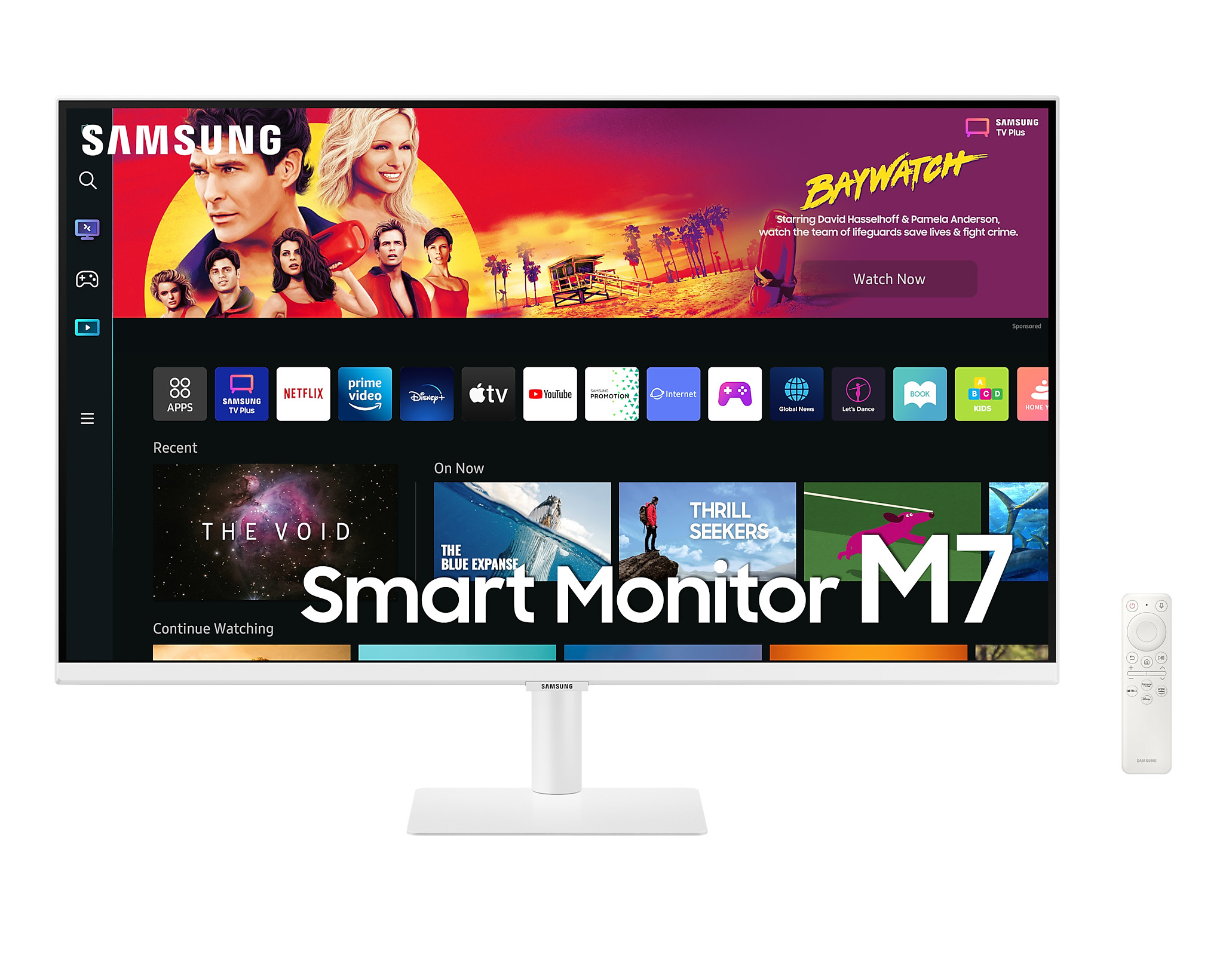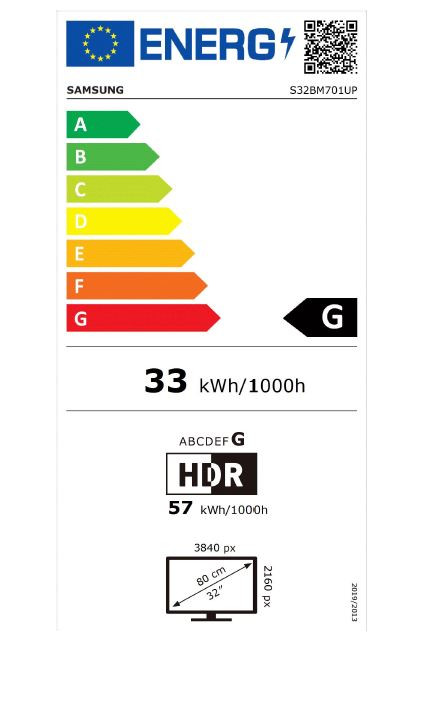







































£302.99*
- Resolution 3840 x 2160 4K UHD
- Diagonal 32"
- Panel type VA
- Refresh Rate 60Hz



Product information
SMART Monitor M7B S32BM701UP
- Resolution: 3,840 x 2.160 pixels
- Entertainment Hub with Smart Apps (Tizen)
- Voice Control via Bixby & Alexa
- Mobile to Screen Mirroring (Smart View, Tap View and AirPlay 2)
- Samsung DeX, Remote Access
- Integrated Speakers
- Smart Home Control via SmartThings App
Monitor and Smart TV in one
The monitor for (almost) all facets of life. With the Smart Monitor, you can enjoy your entertainment, work and chat - all without a separate PC. Your favourite apps for streaming, work and video calls are already integrated, so you can get started right away.

Productive even without a PC
Workspace
No PC needed: surf the web, edit documents and work on projects. With the new Workmode, you can also remotely access another PC, use Microsoft 365 programmes and also connect to Samsung mobile devices with Samsung DeX to work seamlessly.

The series marathon can come
Smart TV experience
Streaming content as far as the eye can see. You can access a variety of streaming apps such as Netflix, YouTube and other streaming services by simply connecting the monitor to a Wi-Fi network. Samsung TV Plus also offers free live and on-demand content with no downloads or sign-in required, while the Universal Guide gives you personalised content recommendations.

Say hello to your friends
SlimFit camera
So you're there for every conversation. The SlimFit camera with tilt feature lets you set the right angle while using your favourite video calling apps like Google Duo, which you can access directly from the screen. Plus, your privacy is protected with the camera cover and the option to detach the camera completely.

Control your smart home
IoT hub
Turn the Smart Monitor into a home control centre by connecting it to your compatible IoT devices with SmartThings. Turn the lights on or off, lower the blinds and set the thermostat to the right temperature - all with the Smart Monitor for a relaxing evening.

Just say what you want
Multiple voice assistants
With the Far Field voice feature, you can activate your voice assistant simply by speaking. Tell the monitor directly what you want - even remotely. The Smart Monitor offers both Bixby and Amazon Alexa.

Your gaming hub
Gaming Hub
Live an immersive gaming experience. The Gaming Hub makes this monitor even more versatile. Now you can watch movies, work and even play games - without any additional devices. Access a wide range of games via Cloud Gaming and jump straight into the action. Just turn on your Smart Monitor and discover modern gaming - without a PC or console.

Quickly set up
Game Bar
Check and adjust game settings in an instant. Now you can easily view the status of key settings such as FPS or HDR, and change the response time or screen ratio and game mode without leaving your game.

See content on the big screen easily
Easily connected
Thanks to AirPlay, you can wirelessly connect Apple devices to the Smart Monitor and view them on a larger screen. Enjoy your favourite iPhone, iPad and Mac content on the Smart Monitor and also mirror apps, documents and websites.
Enjoy content with vivid detail
UHD
Experience stunning picture quality for work and play. With 4 times the pixels of Full HD, the Smart Monitor offers more screen real estate and amazingly lifelike UHD images. During the day, you can work on more documents. And in the evening, you can watch your movies in cinematic 4K quality.

Adaptive brightness in any room
Adaptive Picture
Enjoy appealing viewing at different times of the day and night. A sensor detects the ambient light and automatically adjusts the brightness with Adaptive Picture. Even in daylight, you can see details in your movies, series or multimedia content.

Auto-adaptive sound scene by scene
Adaptive Sound
With built-in speakers and Adaptive Sound, the sound is adapted to your favourite content. The M7 analyses the soundtrack and automatically delivers scene-by-scene optimised sound. This means you can follow dialogue optimally even in quiet scenes. The sound is also adjusted for gripping films, dynamic sports scenes and interesting news.

Seamless connection
USB Type-C
USB Type-C allows you to charge devices, transfer data and also send display signals between devices with just one connection. This simple connection makes for a convenient, uncluttered and comfortable work environment.

Air hidden details in your games
Ultrawide Game View
Keep your eye on the prize. Set your screen to 21:9 to spot hidden areas in game scenes with Ultrawide Game View. Now when you're playing football games, you can see some of the pitch. And in racing games, you get a natural and comprehensive view of the road ahead.
Plug in and go
Auto Source Switch +
You don't have to fuss with your cables. With Automatic Source Switch Plus, your monitor can detect newly connected devices the first time they are plugged in. So you don't have to search for the right input source.
Technical data
| Name | Samsung S32BM701UP 32" VA Monitor, 3840 x 2160 4K UHD, 60Hz, 4ms |
|---|---|
| Article number | 1000027742 |
| GTIN/EAN | 8806094786491 |
| Manufacturer SKU | LS32BM701UPXEN |
| EPREL ID | 1401429 |
| Model name | S32BM701UP |
| Brand | Samsung |
| Product Type | Monitor |
| Product Series | Samsung M7 Series |
| Technology | LCD |
| Panel type | VA |
| Resolution | 3840 x 2160 4K UHD |
| Diagonal | 32" |
| Aspect Ratio | 16:9 |
| Viewing angle - Horizontal | 178° |
| Viewing angle - Vertical | 178° |
| Contrast Ratio | 3,000 :1 |
| Max. Brightness | 300 cd/m² |
| Response time | 4ms |
| Refresh Rate | 60Hz |
| Support - VESA | 100 x 100 |
| Inputs | 1x USB-C , 2x HDMI , 3x USB-A |
| Features | Flicker Free , HDR , Integrated speaker |
| Product width | 71.61 cm |
| Product height | 42.45 cm |
| Product depth | 4.18 cm |
| Weight | 5.5 kg |
| Colour | White |
| EEK Spectrum | A to G |
| Energy efficency class | G |
| Delivery contents | HDMI Cable , Power cable , Remote control |
| Condition | New |
| Warranty | 24 Month |
| Warranty type | Bringin service Service and support information |
Downloads
Product safety
| Person responsible for the EU |
|---|
| Samsung Electronics GmbH |
| Am Kronberger Hang 6 |
| 65824 Schwalbach |
| Germany |
| sseg.comm@samsung.com |



